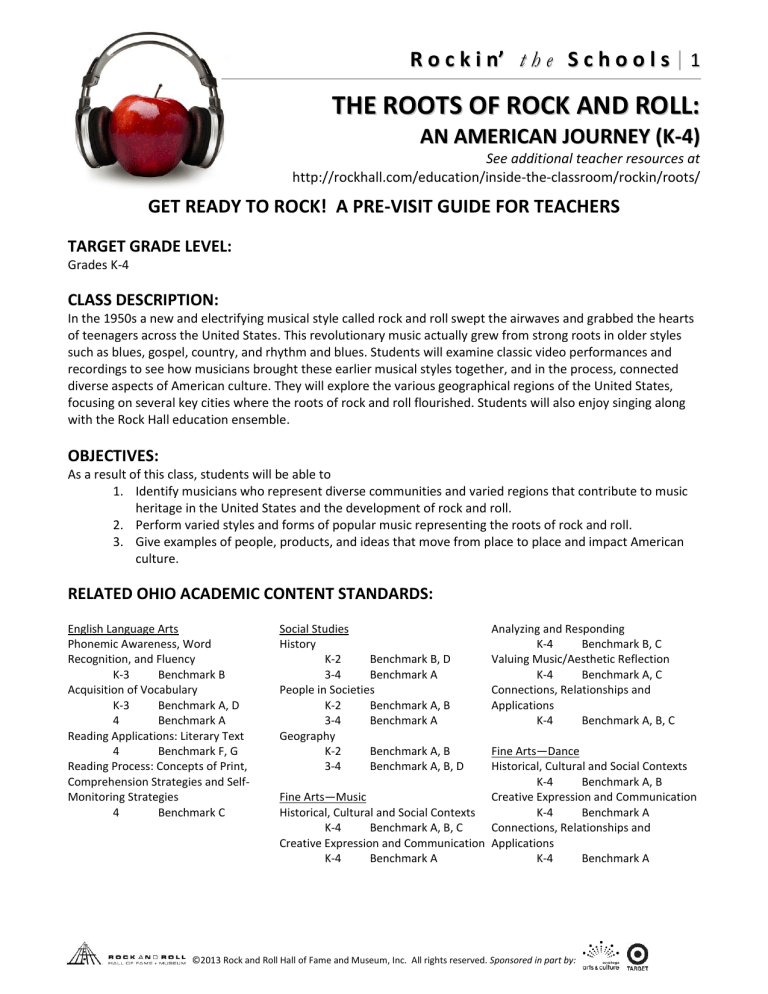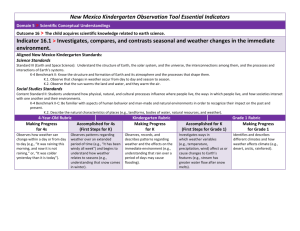Roots (K-4): Pre

R o c c k i i n ’ ’ t t h h e e S c c h o o l l s s | 1
T H E R O O T S O F R O C K A N D R O L L L : :
A N A M E R I I C A N J J O U R N E Y ( ( K 4 ) )
See additional teacher resources at http://rockhall.com/education/inside-the-classroom/rockin/roots/
GET READY TO ROCK! A PRE-VISIT GUIDE FOR TEACHERS
TARGET GRADE LEVEL:
Grades K-4
CLASS DESCRIPTION:
In the 1950s a new and electrifying musical style called rock and roll swept the airwaves and grabbed the hearts of teenagers across the United States. This revolutionary music actually grew from strong roots in older styles such as blues, gospel, country, and rhythm and blues. Students will examine classic video performances and recordings to see how musicians brought these earlier musical styles together, and in the process, connected diverse aspects of American culture. They will explore the various geographical regions of the United States, focusing on several key cities where the roots of rock and roll flourished. Students will also enjoy singing along with the Rock Hall education ensemble.
OBJECTIVES:
As a result of this class, students will be able to
1.
Identify musicians who represent diverse communities and varied regions that contribute to music heritage in the United States and the development of rock and roll.
2.
Perform varied styles and forms of popular music representing the roots of rock and roll.
3.
Give examples of people, products, and ideas that move from place to place and impact American culture.
RELATED OHIO ACADEMIC CONTENT STANDARDS:
English Language Arts
Phonemic Awareness, Word
Recognition, and Fluency
K-3 Benchmark B
Acquisition of Vocabulary
K-3
4
Benchmark A, D
Benchmark A
Reading Applications: Literary Text
4 Benchmark F, G
Reading Process: Concepts of Print,
Comprehension Strategies and Self-
Monitoring Strategies
4 Benchmark C
Social Studies
History
K-2 Benchmark B, D
3-4 Benchmark A
People in Societies
K-2
3-4
Benchmark A, B
Benchmark A
Analyzing and Responding
K-4 Benchmark B, C
Valuing Music/Aesthetic Reflection
K-4 Benchmark A, C
Connections, Relationships and
Applications
K-4 Benchmark A, B, C
Geography
K-2
3-4
Benchmark A, B
Benchmark A, B, D
Fine Arts—Music
Historical, Cultural and Social Contexts
Fine Arts—Dance
Historical, Cultural and Social Contexts
K-4
K-4
Benchmark A, B
Creative Expression and Communication
Benchmark A
K-4
K-4
Benchmark A, B, C Connections, Relationships and
Creative Expression and Communication Applications
Benchmark A K-4 Benchmark A
©2013 Rock and Roll Hall of Fame and Museum, Inc. All rights reserved. Sponsored in part by:
R o c c k i i n ’ ’ t t h h e e S c c h o o l l s s | 2
T H E R O O T S O F R O C K A N D R O L L L : :
A N A M E R I I C A N J J O U R N E Y ( ( K 4 ) )
See additional teacher resources at http://rockhall.com/education/inside-the-classroom/rockin/roots/
SUGGESTED PREPARATION ACTIVITY:
OUR COMMUNITIES, OUR ROOTS
Have students describe places in their community that they like, such as their school or neighborhood. Next ask students to describe special places in their city and/or state. Prompt students to consider what Ohio has that states in different regions, or parts of the United States, do not (i.e. Ohio has snow in the winter, but Florida does not, etc.). Review characteristics of one or more regions of the United States. Have students find pictures from appropriate magazines that represent a specific region of the United States. Students can use these pictures to create a collage. More advanced students may continue to investigate different states and regions by presenting their assigned state’s or region’s history, major products, resources, populations and geographic features to the class.
EXAMPLES TO BE DISCUSSED IN CLASS:
NOTE: Preview all materials for appropriateness for your students.
The Carter Family. “Keep on the Sunny Side of Life.” 1928.
Haley, Bill and His Comets. “Rock Around the Clock.” Rock Around the Clock , 1954.
Big Mama Thornton. “Hound Dog.” 1952.
Elvis Presley. “Hound Dog.” 1956.
The Penguins. “Earth Angel.” 1954.
Frankie Lymon and the Teenagers. “Baby, Baby.” Baby, Baby, 1957.
The Beatles. “Twist and Shout.” Please Please Me , 1963.
Free, streaming videos of most performances can be found on www.youtube.com
or blip.fm
Free, streaming audio tracks of most songs can be found on www.grooveshark.com
, www.spotify.com
or blip.fm
©2013 Rock and Roll Hall of Fame and Museum, Inc. All rights reserved. Sponsored in part by:
R o c c k i i n ’ ’ t t h h e e S c c h o o l l s s | 3
T H E R O O T S O F R O C K A N D R O L L L : :
A N A M E R I I C A N J J O U R N E Y ( ( K 4 ) )
See additional teacher resources at http://rockhall.com/education/inside-the-classroom/rockin/roots/
GLOSSARY
Blues: A style of music created by African Americans in the South, often with verses of three lines that tell stories in everyday language
Chorus: The line or lines that are repeated in music often with the same musical accompaniment
Country: A style of music created by Anglo-Americans in the South, often featuring stringed instruments such as fiddles, autoharps, guitars, or dulcimers
Doo-wop: A vocal group harmony style loved by teens in northern cities, where backup singers sing repeated words or nonsense syllables
Harmony: Two or more different pitches (or notes) that sound at the same time: the parts of a song that accompany the melody (or tune)
Rock and roll: A form of American music with a lively beat that began in the 1950s; this music blends blues, rhythm and blues, gospel, and country music
Roots: 1) the parts of plants that provide nutrients; 2) the older music and traditions used to create new music
Region: an area that includes smaller places, usually sharing similar features of land, weather, and/or customs
Rural: Of or relating to the country, farming, or people in farming communities
Verse: A section of lyrics that tells part of the song’s story and is similar to a verse in a poem
Urban: Of or relating to a city or heavily populated area
©2013 Rock and Roll Hall of Fame and Museum, Inc. All rights reserved. Sponsored in part by:







